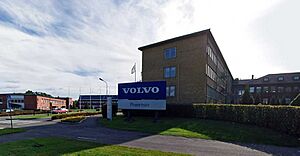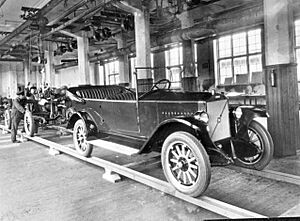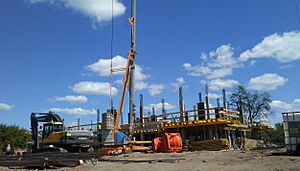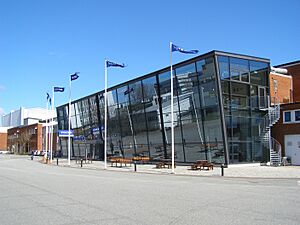Volvo facts for kids
| Aktiebolag | |
| Traded as | OMX: VOLV A, OMX: VOLV B OMX Stockholm 30 |
| ISIN | ISIN: [https://isin.toolforge.org/?language=en&isin=SE0000115446 SE0000115446] |
| Industry | Automotive |
| Founded | 1927 |
| Founders | Assar Gabrielsson and Gustav Larson |
| Headquarters | Gothenburg, Sweden |
|
Area served
|
Worldwide |
|
Key people
|
|
| Products | Trucks, buses, construction equipment, marine and industrial engines, customer financing, insurance and related services, product related services |
| Brands |
|
| Revenue | |
|
Operating income
|
|
| Total assets | |
| Total equity | |
| Owners |
|
|
Number of employees
|
|
| Subsidiaries |
|
The Volvo Group (also known as AB Volvo) is a big Swedish company. It is based in Gothenburg, Sweden. Volvo Group mainly makes and sells trucks, buses, and construction machines. They also provide engines for boats and industries. Plus, they offer financial services to their customers. In 2016, Volvo Group was the second-largest maker of heavy-duty trucks in the world.
Volvo started in 1927. At first, they made cars. Over time, they grew into other areas of manufacturing. The company that makes Volvo cars, Volvo Cars, used to be part of AB Volvo. But in 1999, it was sold to the Ford Motor Company. Since 2010, Geely Holding Group has owned Volvo Cars. Both AB Volvo and Volvo Cars use the same Volvo logo. They also work together to run the World of Volvo museum in Gothenburg.
AB Volvo first appeared on the Stockholm Stock Exchange in 1935. This means people could buy and sell shares of the company. It was also listed on the American NASDAQ stock exchange from 1985 to 2007. Volvo is one of Sweden's biggest companies.
Contents
History of Volvo Group
How Volvo Started and Grew
The name Volvo was first used in 1911. It was meant for a new type of SKF ball bearings. The word "Volvo" means "I roll" in Latin. This idea for bearings did not last long. SKF decided to use its own initials for its products instead.
In 1924, Assar Gabrielsson, a sales manager, and Gustav Larson, an engineer, decided to build a Swedish car. They wanted to make cars strong enough for Sweden's rough roads and cold weather.
AB Volvo officially began on August 10, 1926. After a year of making ten test cars, the company was ready to start building cars. The Volvo Group itself says it started in 1927. That is when the first car, a Volvo ÖV 4, rolled off the factory line in Gothenburg. Only 280 cars were built that year. The first truck, called the "Series 1," came out in January 1928. It was an instant success and got attention from other countries.
By 1930, Volvo sold 639 cars. Soon after, they started exporting trucks to Europe. Volvo cars did not become well known outside Sweden until after World War II. AB Volvo was listed on the Stockholm Stock Exchange in 1935. SKF then sold its shares in the company. By 1942, Volvo bought a Swedish engineering company called Svenska Flygmotor.
Pentaverken, a company that made engines for Volvo, was bought in 1935. This helped Volvo get a steady supply of engines. It also allowed them to start making marine engines for boats.
The first bus, named B1, was launched in 1934. Aircraft engines were added to Volvo's products in the early 1940s. Volvo also made the Stridsvagn m/42 tank. In 1963, Volvo opened its first assembly plant outside Sweden. This plant was in Halifax, Nova Scotia, Canada.
In 1950, Volvo bought Bolinder-Munktell, a Swedish company that made construction and agricultural equipment. Bolinder-Munktell became Volvo BM in 1973. Later, Volvo BM's farm equipment business was sold. The remaining construction equipment business became Volvo Construction Equipment.
In the 1970s, Volvo started to focus more on heavy commercial vehicles. They wanted to make fewer cars and more trucks and buses.
Working with Other Companies
In 1977, Volvo tried to join with another Swedish car company, Saab-Scania. But Saab-Scania said no.
Between 1978 and 1981, Volvo bought Beijerinvest. This was a trading company involved in oil, food, and finance. By 1981, these areas made up about three-quarters of Volvo's money. The car part was most of the rest. In 1982, Volvo finished buying parts of White Motor Corporation.
In the early 1970s, the French company Renault and Volvo started working together. In 1978, Volvo Car Corporation became a separate company within the Volvo group. Renault bought a small part of it, but sold it back later. In the 1990s, Renault and Volvo worked even more closely. They partnered on buying parts, research, and quality control. They also owned parts of each other's companies.
In 1993, Volvo and Renault announced they would merge. The deal was accepted in France but not in Sweden. Volvo shareholders and the company board voted against it. The plan was officially stopped in February 1994. Volvo sold its part of Renault in 1997. In the 1990s, Volvo also sold off most of its businesses that were not about vehicles or engines.
In 1991, Volvo Group worked with the Japanese carmaker Mitsubishi Motors. They built cars together at a factory in the Netherlands. This factory made the Mitsubishi Carisma and the Volvo S40/V40 cars. In the 1990s, Volvo also partnered with the American company General Motors. In 1999, the European Union stopped Volvo from merging with Scania AB.
Focusing on Heavy Vehicles
In January 1999, Volvo Group sold Volvo Car Corporation to Ford Motor Company for $6.45 billion. This car division joined Ford's group of luxury brands. Volvo's engineering and parts were used in some Ford, Land Rover, and Aston Martin vehicles. For example, the second generation Land Rover Freelander used the same base as the second generation Volvo S80.
In November 1999, Volvo Group bought a small part of Mitsubishi Motors. This was part of a deal for their truck and bus businesses. In 2001, after another company bought a large part of Mitsubishi Motors, Volvo sold its shares.
Renault Véhicules Industriels (which included Mack Trucks) was sold to Volvo in January 2001. Volvo changed its name to Renault Trucks in 2002. Renault became the biggest shareholder in AB Volvo as part of this deal.
AB Volvo bought 13% of the shares in the Japanese truck maker Nissan Diesel in 2006. Volvo Group took full ownership of Nissan Diesel in 2007. This helped Volvo grow its business in Asia.
Renault sold most of its shares in AB Volvo in October 2010. They sold their remaining shares in December 2012. This made a Swedish investment group the largest shareholder. In 2017, Geely, the owner of Volvo Cars, became the largest Volvo shareholder by number of shares.
In December 2013, Volvo sold its construction equipment rental division. In November 2016, Volvo said it wanted to sell its Government Sales division, which made military vehicles. This plan was later stopped. In May 2018, Volvo changed the name of Renault Trucks Defense to Arquus.
In December 2018, Volvo announced it would sell most of its WirelessCar company to Volkswagen. WirelessCar helps cars connect to the internet. Volvo wanted to focus on connecting commercial vehicles instead. The sale was finished in March 2019.
In December 2019, Volvo and Isuzu announced they would work together on commercial vehicles. Volvo would sell UD Trucks to Isuzu as part of this deal. The sale was completed in April 2021.
In the early 2020s, Volvo partnered with other companies. They wanted to build ways to power vehicles without fossil fuels. In April 2020, Volvo and Daimler announced that Volvo would buy half of Daimler's fuel cell business. They formed a joint company called Cellcentric in March 2021. In December 2021, Volvo, Daimler Truck, and Traton agreed to build an electric vehicle charging network for heavy vehicles in Europe. This joint company, called Milence, started in December 2022.
In April 2021, Volvo announced a new partnership with SSAB. They plan to develop steel made without fossil fuels for future Volvo vehicles. In November 2023, Volvo bought Proterra's battery business.
Volvo is also developing trucks that run on hydrogen. They plan to start testing these trucks in early 2026.
What Volvo Group Does
Volvo's Main Businesses
The Volvo Group has many different businesses:
- Volvo Trucks: Makes trucks for regional and long-distance transport. Also makes heavy-duty trucks for construction.
- Mack Trucks: Makes trucks for local delivery and long-distance transport in North America.
- Renault Trucks: Makes heavy-duty trucks for regional transport and construction in Europe.
- Arquus: Makes military vehicles.
- Dongfeng Commercial Vehicles (45% owned by Volvo): Makes trucks in China.
- VE Commercial Vehicles Limited Ltd., India (VECV) (45.6% owned by Volvo): Makes trucks and buses in India.
- Volvo Construction Equipment: Makes machines for construction work.
- SDLG (70% owned by Volvo): Makes construction equipment in China.
- Volvo Group Venture Capital: This is Volvo's investment company.
- Volvo Buses: Makes complete buses and bus parts for city, line, and tourist travel.
- Volvo Financial Services: Helps customers get loans and insurance for Volvo products.
- Volvo Penta: Makes engines for boats and industrial machines.
- Volvo Energy: Manages and supports electric vehicles, batteries, and charging networks.
In 2021, almost two-thirds (62%) of Volvo's money came from trucks and related services. Construction equipment brought in 25%. The rest came from buses, marine engines, and smaller operations.
Where Volvo Makes Things

Volvo has many factories around the world. As of 2022, they have plants in 19 countries. Another 10 countries have independent companies that put Volvo products together. Volvo also has places for developing new products, distributing them, and managing logistics.
Volvo's first factory was in Gothenburg, Sweden. In 1930, Volvo bought its engine supplier in Skövde. In 1942, Volvo bought its transmission supplier in Köping. Volvo built a new truck factory in Gothenburg in 1954. They also built a car factory in Torslanda between 1959 and 1964.
In the 1960s and early 1970s, Volvo opened factories in Canada, Belgium, Malaysia, and Australia. Volvo also started making vehicles other than cars and road trucks. They bought the Eskilstuna plant, which made construction equipment. From the 1970s, Volvo set up more factories in Sweden. They also bought the Dutch DAF car plants. Volvo built its first South American factory in Curitiba, Brazil.
From the mid-1970s, Volvo started building factories with smaller assembly lines. These lines focused more on workers and used automation better. Examples include Kalmar (car assembly, built in 1974) and Tuve (truck assembly, 1982). Kalmar was closed in the early 1990s. The Tuve plant replaced the old Gothenburg truck factory. In 1982, Volvo got its first plant in the United States, in Dublin, Virginia.
Starting in the late 1980s, Volvo expanded its bus production. They bought bus companies in Sweden, Denmark, Germany, Canada, Finland, and the United States. In the late 1990s, Volvo built its main bus factory for Europe in Wrocław, Poland. In the 1990s, Volvo also grew its construction equipment business. They bought the Swedish company Åkerman and Samsung's construction equipment division. In 1998, Volvo opened a factory for trucks, construction equipment, and buses near Bengaluru, India.
Volvo sold all its car manufacturing businesses in 1999.
After buying Renault Véhicules Industriels and Nissan Diesel in the 2000s, Volvo gained many factories in Europe, North America, and Asia.
In 2014, Volvo Construction Equipment bought the haul truck manufacturing part of Terex Corporation. This included five truck models and a factory in Scotland.
| Volvo Production Sites (as of October 2022) | |
|---|---|
| Company | Plants |
| Volvo Trucks |
|
| Renault Trucks |
|
| Mack Trucks |
|
| Volvo Construction Equipment |
|
| Volvo Buses |
|
| VE Commercial Vehicles |
|
| Dongfeng Truck |
|
| SDLG |
|
| Volvo Penta |
|
| Notes | |
Minority owned by Volvo.
|
|
| Sources | |
The Volvo Brand Name
Volvo Trademark Holding AB is a company owned equally by AB Volvo and Volvo Car Corporation.
This company's main job is to own, protect, and keep safe the Volvo brand names. This includes the word Volvo, the Volvo logos (like the grille slash and iron mark), and Volvo Penta. They also give permission for these names to be used by their owners. They work every day to keep the Volvo trademarks registered around the world. They also make sure the protection for these trademarks is strong enough.
Another important job is to stop people from using or registering trademarks that are too similar to Volvo's. This includes stopping counterfeit (fake) products globally.
Working with Universities
Volvo works closely with several universities and colleges. They do this for research and to find new employees. Some of these schools include Penn State University, INSA Lyon, EMLYON Business School, NC State University, Sophia University, Chalmers University of Technology, The Gothenburg School of Business, Economics and Law, Mälardalen University College, and the University of Skövde.
Fun Communication Campaigns
In November 2013, Volvo Trucks had actor Jean-Claude Van Damme do a split. He did it between two moving trucks that were driving backward. This campaign was called "Epic Split." It showed how stable and precise their "Dynamic Steering" model was. In just three weeks, the video became very popular. It got over 61 million views on YouTube.
Two years after the "Epic Split," Volvo Trucks wanted to show how tough one of their trucks was. They let a four-year-old girl named Sophie control the truck. The video showed Sophie using a remote control to drive the truck through different obstacles. This proved how strong and accurate the vehicle was.
See also
 In Spanish: AB Volvo para niños
In Spanish: AB Volvo para niños
- Port of Gothenburg




